The phrase
"Wonder Horses" refers to the equine companions of cowboy heroes in early Western films. What makes these horses different from others that have appeared on the silver screen is their rise from trusty steed to a genuine screen personality. There have been a number of horses who have enjoyed such fame, often receiving equal or second billing with their human costars.Heroic horses of the silver screen
Though the first heroic horses emerged from the silent film era, they were prominently
featured in the B-Westerns of the 1930s, 1940s, and 1950s. During the early decades of
sound film, cowboy movies targeted a juvenile demographic. The film's heroes were
generally one-dimensional, stock characters who represented and promoted truth and
goodness to their young audience. More popular with adolescent viewers than a human
sidekick, the Wonder Horse could not only outrun the mounts of the villains, but could also
perform a series of feats and tricks to ensure that the cowboy hero would triumph.
The bond between a cowboy and his horse is an important part of the cowboy mythology
created by dime novels, pulp fiction stories, and Western cinema. Movies featuring Wonder
Horses embellish this relationship between man and beast while heightening the exceptional
and heroic qualities of the cowboy by his association with a remarkable animal.
FRITZ
Fritz was the first horse to be named in the credits as a costar to his
rider, William S. Hart, appearing in at least eight silent films. He received his own fan mail,
which often included sugar cubes from admirers. Fritz was known for his ability to do unique
and risky stunts. He could jump into moving rivers, through windows, over fire, and "allow
himself to be thrown to the ground after a sudden stop."
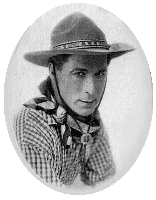
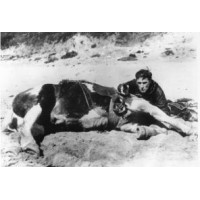
TONY
The first horse to bear the name The Wonder Horse, Tony was the
companion of actor Tom Mix. He starred in over two dozen silent and sound films during his
career, becoming a celebrity in his own right. When Mix placed his handprints in the cement
outside Grauman's Chinese Theater in 1927, Tony's hoofprints were placed alongside them.
He was the first horse to be given equal billing with his human costar, and was featured in
the title of three movies. Tony is most known for his intelligence and ability to perform
remarkable stunts, many of which would not be allowed today due to the danger involved.
Tony performed in the years before the American Humane Association oversaw the use of
animals on American productions. Since animals do not 'agree' to be actors (cannot verbalize
agreement) the American Humane Association began to oversee how animal labor was created,
filmed, and commercialized in 1940, 8 years after Tony's retirement.
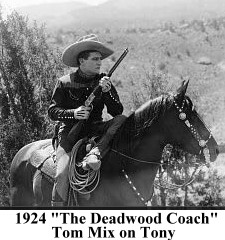
Known as The Wonder Horse and King of the Wild Horses, Rex was a black Morgan stallion with a fierce reputation. Despite the fact that over the years he was termed mean, vicious, ornery, undependable, warped, and dangerous, Rex was in the film industry for nearly fifteen years, starring in over a dozen films. Few actors were willing to work with the wild horse, so a double was often used in close-ups. He was the first horse to star in his own films.
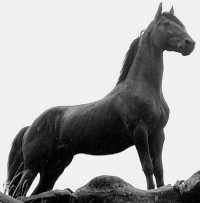
TARZAN
Tarzan, The Wonder Horse was the onscreen companion to silent and
sound film star Ken Maynard. Together, the two starred in over five dozen films and serials
from 1925 until Tarzan's death in 1940. While previous Wonder Horses had been used by
their cowboy costars to perform impressive stunts, actor Ken Maynard was the first to take
advantage of the merits of a talented horse. While Tarzan could perform stunts like jumping
off cliffs, he was known better for his tricks, such as dancing, bowing, nodding his head to
answer questions, playing dead, untying ropes, dragging Maynard to safety, or nuzzling him
into the arms of the leading lady. Incredibly intelligent, Tarzan performed these stunts in
response to word commands from Maynard.
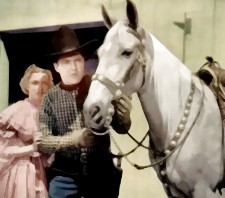
CHAMPION
Champion the Wonder Horse, originally owned by Tom Mix,
was purchased and became the onscreen companion of the singing cowboy Gene Autry.
Several horses bore the name Champion; the first died while Autry was serving in the Army
Air Force during World War II. Champion was able to perform numerous tricks, including
jumping through paper-covered hoops. Gene Autry and Champion left their handprints and
hoofprints in the cement outside Grauman's Chinese Theater in 1949.
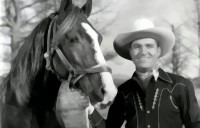
TRIGGER
One of the most well-known Wonder Horses was Roy Rogers'
palomino stallion, Trigger. He appeared in all 81 of Rogers' films as well as 101 television
shows. He retired from show business in 1957, dying in 1965 at the age of 33; he was stuffed
and the taxidermy mount resided at the Roy Rogers Museum in California and then in
Branson, Missouri, until its closure. Trigger was billed as "The Smartest Horse in the Movies."
as being "almost human," knowing as many as 60 different tricks. Like Tarzan, many of his
tricks were performed by word cue.
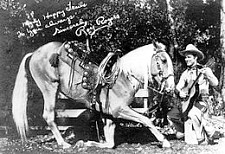
Notable Wonder Horses
- Baron with Tom Tyler
- Black Jack and Feather with Allan Lane
- Champion with Gene Autry
- Cyclone with Don Barry
- Duke with John Wayne
- Falcon with Buster Crabbe
- Fritz with William S. Hart
- King with Bill Cody
- Knight with Rod Cameron
- Koko "The Miracle Horse of the Movies" with Rex Allen
- Lightning and Duke with Tim Holt
- Midnight with Tim McCoy
- Mike with George O'Brien
- Mutt with Hoot Gibson
- Raider with Charles Starrett
- Rebel with Reb Russell
- Rex as himself
- Rush with Lash LaRue
- Scout with Jack Hoxie
- Shamrock with Bob Livingstone
- Silver with Buck Jones
- Silver with the Lone Ranger
- Silver with Sunset Carson
- Silver Bullet with Whip Wilson
- Silver King with Fred Thomson
- Sonny and Thunder with Wild Bill Elliott
- Starlight with Jack Perrin
- Tarzan with Ken Maynard
- Tony with Tom Mix
- Topper with Hopalong Cassidy
- Trigger with Roy Rogers
- White Eagle and Silver with Bug Jones
- White Flash with Tex Ritter
 page
page